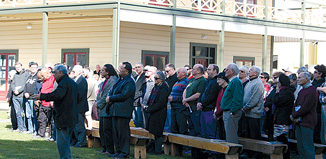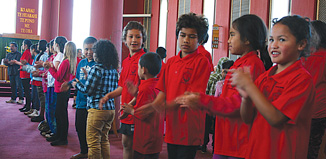Te Hikoi o Te Rongopai Ki Te Kapiti, a celebration of the bringing of the gospel to Kapiti almost 200 years ago, saw 700-800 people involved in various stages from Kenakena Park to Otaki.
“It’s been a great day, we’ve explored the wonderful history and diversity of this place, Anglican. Wesleyan (Methodist) and Catholic history, explored the pre-eminent role of local Maori,” Wellington Anglican Bishop, Justin Duckworth said after the final meal. “The missionaries just supported what the Maori were already doing, with the missionaries behind them. We took courage from our story, about how we would proclaim the good news of Jesus, going forward, to the present day and beyond.”
Organised by the Wellington Anglican Diocese and local churches in Otaki, the hikoi celebrated the proclamation of the Gospel on the Kapiti Coast. Maori who had been captured during war with northern tribes, were the first messengers of this new way of love and forgiveness, when they were released and returned to their own tribes in the early 1830’s. Kenakena Pa was built in the 1830’s. It was the site of the first church.
About 300 people from throughout the Wellington Diocese joined the first stage of the hikoi at Kenakena Park, where they were greeted with a powhiri and told the beginning of the Gospel of Christ being brought to Kapiti. Bishop Justin, wearing his “trademark” jandals, was among the pilgrims.
From there, most of the travellers moved to St Luke’s Church in Waikanae, where they heard more of the history of the growth of Christianity in the region, and heard the story of a young Maori girl, Tarore and her precious bible, brought down to Kapiti by the released warriors.
On to Otaki and the historic Pukekaraka Mission site, marae and St Marys Church. Many new groups joined the hikoi pilgrims for the celebrations in Otaki. They were all welcomed onto the Marae with a powhiri; this is one of only two Marae in New Zealand not affiliated to a Maori tribe. Through speakers and waiata, more of the history of the region was told. This was followed by a screening of early films from1930’s, showing life at the mission and the 1950 Easter hui attended by 3000 people.
In 1844 Father Jean Baptiste Compte, a young French Marist priest, set up the first Catholic mission at Waikawa then secondly at Pukekaraka.
The church was built in 1859 and is the oldest Catholic Church still in use in New Zealand.
Next stop was Rangiatea Church and the Youth Celebration. The young people, teens down to five years, enacted the story of Tarore and her book, read in both te reo and English, as they acted the events.
A brief history of the church was given. The original Rangiatea Church was opened in 1851, was used by Maori and the Anglican community together, until the early 1900’s when the first All Saints was built to meet the specific needs of the European community.
Some of the history of Rangiatea was told, its meaning Rangi – heaven, atea-space, so it became a place of peace and worship. The tukutuku panels along the walls are a sign from their ancestors of the church filled with the descendants of Abraham and Sarah (Book of Genesis Chapter 17 verse 15-16).
Bishop Kito Pikaahu, spoke of the day’s events, from the pilgrimage’s start at Kenakena, its bringing all the people together in Otaki. “From its earliest days, it (embracing Christianity) has transformed people, transformed communities,” he told the pilgrims, who filled the church to standing room only.
“What stood out for me – this amazing day with all of us together,” Bishop Justin said. “The Gospel of Jesus Christ transforms society, those fighting become peaceful. The good news of Jesus Christ makes a difference, so it transforms lives.”
To bring the day to a close, everyone made the short walk to Hadfield Hall, just 200 metres along the road for a Celebratory Feast, rather like the feeding of the 5000 – hangi and savoury dishes, with sweet slices to finish the meal. Staff and parents of Te Kura-a-iwi O Whakatupuranga Rua Mano had prepared and cooked the hangi for 300 people; there was plenty for everyone and about 20 to spare, though they soon went too.
Christmas Day 2014 will see the celebration of the bi-centennial year of the first time the gospel preached at Oihi, in the Bay of Islands in 1814, by the missionary Samuel Marsden.

